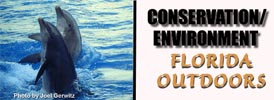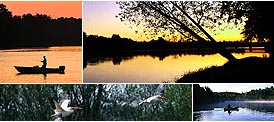
Cypress Swamps | Hardwood Swamps | Freshwater Marshes | Beaches & Dunes | Maritime Forest | Salt Marsh | Mangroves


The southern tip of the state is home to one of the most unique ecosystems not only in Florida but also in the United States. The Florida Everglades can be divided into three regions. The most famous is the River of Grass, a term coined by the late Marjory Stoneman Douglas. This expansive freshwater sawgrass marsh occupies the eastern half of the south Florida peninsula. It was once the lush feeding ground for millions of herons, egrets, ibis, and other wading birds.
Over the years, people changed this part of the Everglades by constructing hundreds of miles of drainage canals and a series of water control structures. The great, grassy fresh water wetland is now severely threatened and the bird population is dangerously low. Despite this trouble, the region remains one of the better wildlife watching destinations in the country.
West of the River of Grass, the sawgrass marshes give way to cypress trees, pine islands, and wet prairies of The Big Cypress Swamp. Encompassing nearly 750,000 acres, the Big Cypress National Preserve encompasses much of the swamp. The National Park Service manages the Preserve.
Nearby the Preserve are the Florida Panther and Ten Thousand Islands National Wildlife Refuges, Fakahatchee Strand State Reserve, Picayune Strand State Forest, and National Audubon Society's Corkscrew Swamp Sanctuary. Together these areas make up another 100,000 acres of preserved land in southwest Florida. Along with the Big Cypress, these lands are some of the least hospitable but most beautiful natural areas in the eastern United States. The region is noted for its unique plants and animals including, rare orchids, alligators, and the endangered wood stork, West Indian manatee, and Florida panther.
The third part of the Everglades looks like a green ribbon dappled in brown that winds its way along the coast. The green color comes from tropical mangrove trees that flourish along much of the south Florida coast. Mangroves are unique trees that can withstand life in the saltwater environment. The trees are a vital link to the food web along the south Florida coast.
The brown is the tea colored coastal waters that, combined with the mangroves, forms the Ten Thousand Islands and Florida Bay part of the Everglades system. This is an area where the water ranges from fresh to full-strength seawater. The freshwater flows from the Everglades and Big Cypress Swamp to the coast where it mixes with salt water from the Gulf of Mexico. This dynamic are, known as an estuary, is home to nearly three fourths of all the fish and shellfish that live in the warm waters off Floridaís coast.
The natural resources of the Everglades are at risk because of decades of mis-understanding of the importance of this ecosystem and the resulting mis-management of the resources. The signs of neglect are obvious: wading birds which once numbers over a million are down to about 100,000 and the Florida panther, once widely distributed in Florida is down to less than 50 individual and a massive campaign to save the species is underway; The Everglades is dying before our eyes.
Hopefully, help is on the way in the form of a long term, multi-billion dollar campaign to restore the south Florida ecosystem. It begins with a plan to re-do the 1400 mile man-made plumbing system and re-create a more natural flow of freshwater through the Everglades. With time, large parts of the landscape will begin to look and function as they did a hundred years ago. Hopefully the native plants and animals will find the changes to their liking and start to increase in numbers. It is manís greatest attempt to repair a broken ecosystem.












